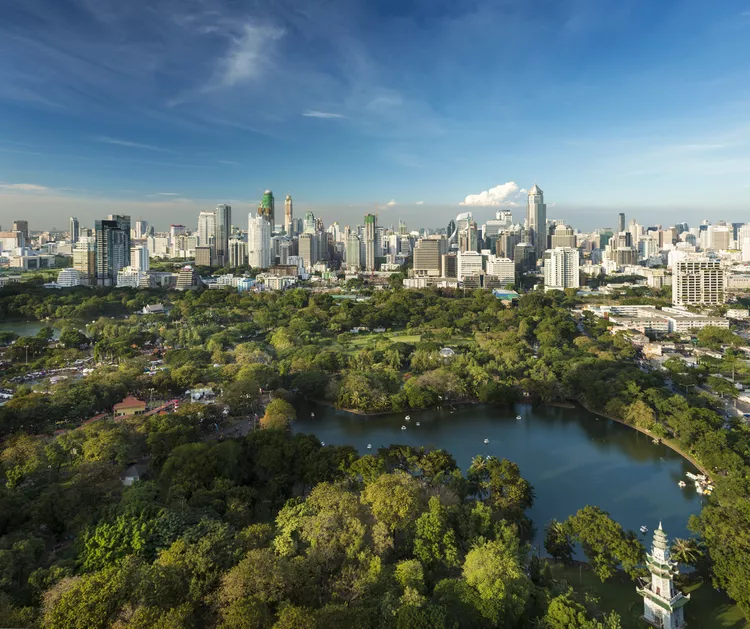Summary
What is Lumpini Park?
Bangkok’s Lumpini Park (pronounced “Loom-pee-nee”) is a 142-acre oasis in the heart of Thailand’s capital. Urban green spaces like this are invaluable, especially in a bustling city of over 8 million residents. Therefore, Lumpini Park provides a necessary escape from the hectic streets of Bangkok.
Consequently, it offers people a chance to relax, exercise, and engage with the various activities available daily. Moreover, Lumpini Park features permanent facilities and seasonal attractions, making it a popular destination for both locals and tourists seeking more than just a place to lounge.
History
Lumpini Park is named after Lumbini, the birthplace of Siddhartha Gautama, who later became known as Buddha, in Nepal. The area was designated from royal lands in the 1920s and converted into Bangkok’s first park, which remains the largest in the city today.
During World War II, Thailand experienced an invasion by Japanese forces in 1941. Japanese soldiers used Lumpini Park as a camp, and subsequent Allied bombings affected the area. The statue of King Rama VI, who initiated the park’s creation, was erected in 1942.
How to Get to Lumpini Park
Lumpini Park’s central location makes it easily accessible by train, though it’s a bit distant from the Khao San Road / Soi Rambuttri area, where no public transport lines reach.
Most of Lumpini Park is enclosed by walls requiring entry through one of the six gates. The main entrance is conveniently situated in the southwestern corner near the royal monument and MRT station.
By Train: The Silom MRT station (Blue Line) is positioned in the southwestern corner of Lumpini Park, while the Lumpini MRT station lies at the southeastern corner. The nearest BTS (skytrain) station is Sala Daeng, just south of the park, located along the BTS Silom Line. If you’re coming from the Sukhumvit Line, be prepared to change lines at the Siam BTS station.
From Khao San Road: The walk to Lumpini Park from Khao San Road takes approximately 90 minutes. Opting for a taxi is usually the easiest route; however, if drivers refuse to use the meter, simply find another cab. If you wish to try a tuk-tuk once in Bangkok, it’s important to note that negotiating the fare beforehand is essential, and avoid agreeing to stop at shops along the way, as this can be a common scam.
What to Know Before Visiting
- Park hours run from 4:30 a.m. to 9 p.m.
- Smoking is prohibited throughout the park, and offenders can be fined.
- Dogs are not permitted.
- Cycling is banned after 3 p.m.
- Wi-Fi is available, but use it cautiously as it can be unsecured.
- Sleeping in the park is not allowed, though a short nap might go unnoticed.
- Excessive displays of public affection are generally frowned upon in Thai culture.
Where to Eat in the Park
Food carts are plentiful, particularly around the main entrance in the southwestern section. For more authentic options, seek vendors along the northern edge of the park. Many carts cater to morning fitness enthusiasts, so lunch options may diminish by noon.
The Giant Lizards in Lumpini Park
Giant monitor lizards inhabit the park’s lake, looking quite similar to Komodo dragons but thankfully not dangerous. While they belong to the same family, their temperament can become unpredictable when cornered. In Thai, the word for these lizards (hia) is also a slang insult, indicating it’s best to keep your distance.
The monitor lizards in Lumpini Park have been growing in both size and boldness, attracting and startling visitors. In 2016, the government relocated around 100 large lizards, yet many remained behind. They play an important role in the ecosystem, serving as scavengers for dead animals.
Despite being non-threatening, some monitor lizards can approach 10 feet long. Thus, feeding or engaging with them is strongly discouraged.
:max_bytes(150000):strip_icc():format(webp)/TAM_5480-5c13fe42c9e77c00014351a3.jpg)
Things to Do in Bangkok’s Lumpini Park
With 142 acres of parkland, it wanders into the daily lives of over 15,000 people. Therefore, don’t anticipate much privacy.
Lumpini Park features both permanent attractions such as an outdoor gym, an indoor dance hall, and Bangkok’s first library. Several groups host activities, especially on weekends, with many clubs typically meeting in the cooler evenings.
Mornings are particularly vibrant, as countless individuals gather to exercise. Jogging two laps around the park is equivalent to completing a 5K!
- Exercise: Jogging, cycling, and rollerblading are popular, while groups often convene for tai chi, Zumba, aerobics (between 5 and 6 p.m.), and even break dancing—most of which are free to join.
- Rent a Boat: Experience riding a large swan pedal boat or choose to row.
- Meet People: Take the opportunity to engage with locals and participate in community groups like bird-watching, photography, or even English practice with shy students.
- Enjoy the Music: During the dry season, free orchestra performances occur on weekend evenings, alongside different music genres and karaoke available at various times.
Other Nearby Options
Visitors can easily walk to Erawan Shrine, Bangkok’s famous sidewalk shrine, in just 15 minutes along Ratchadamri Road, which forms the park’s western boundary.
For those who prefer not to sample food stalls, Lumpini Park is surrounded by cafes and eateries. Furthermore, the large shopping malls MBK and Terminal 21, which both feature food courts, are only a 30-minute walk away or a similar MRT journey.
Additionally, the vicinity around Lumpini Park is rich with attractions such as health spas, a Geological Museum (located due east), and a snake farm on Rama IV Road. The “CityCity” Gallery is just a 10-minute stroll south of the park.




